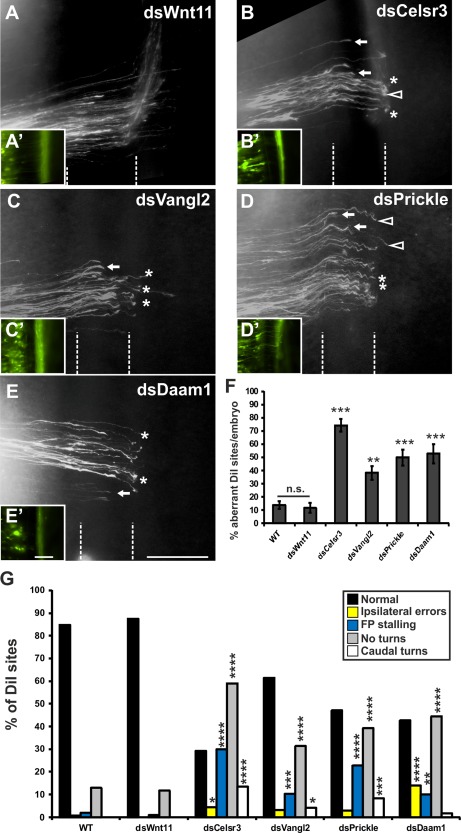Figure 2.

The PCP pathway is involved in commissural axon guidance in the chicken embryo. (A) Injection and electroporation of double‐stranded RNA derived from Wnt11 (dsWnt11) used as control had no effect on postcrossing commissural axon guidance. All axons crossed the floor plate (dashed lines) and turned rostrally. (B–F) Downregulation of the PCP pathway proteins Celsr3 (B), Vangl2 (C), Prickle (D), and Daam1 (E) interfered with axon guidance at the floor plate (F). Axons were mainly found to stall in the floor plate (arrows), failed to turn rostrally into the longitudinal axis on floor‐plate exit (asterisk) or even turned caudally (open arrowheads). (A'–E') Renilla‐GFP confirms efficient transfection. (G) Detailed analysis of the prevalence of different phenotypes. DiI injection sites with normal axonal pathfinding (black bars), ipsilateral errors (yellow bars), floor‐plate stalling (blue bars), no turning at the floor‐plate exit site (gray bars), and caudal turns (white bars) were analyzed separately. See text for details. For statistical analysis of experimental compared to control‐treated embryos we used one‐way ANOVA with Dunnett's test in (F) and two‐tailed Fisher's exact test in (G). *p < 0.05, **p < 0.01, ***p < 0.001, ****p < 0.0001, n.s.: not significant, the floor plate (FP) is indicated by dashed lines in A–E, A'–E'. Scale bars: 100 µm. [Color figure can be viewed in the online issue, which is available at wileyonlinelibrary.com.]
